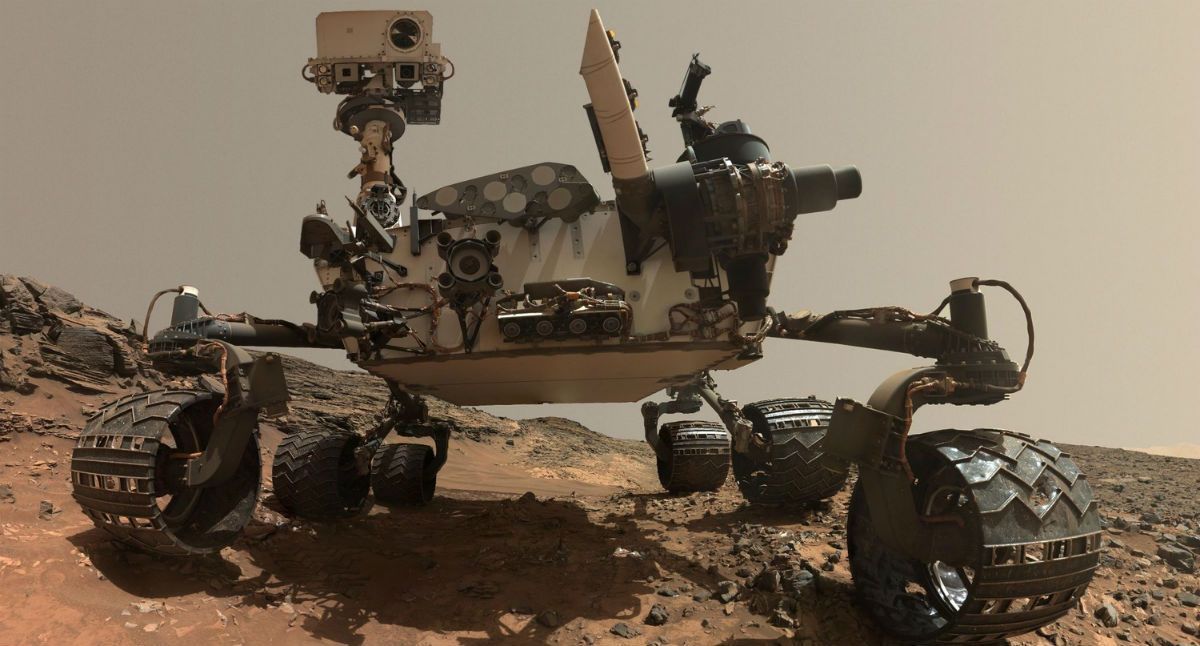Perhaps the most widely-known robotic vehicle in NASA's current arsenal goes by the name Curiosity. Having driven around the obstacle course of Mars for well over three years now, this car-sized rover is engaged in an ongoing mission to unravel the geological history of our little red planetary cousin.
 All Mars robots are super into selfies. Image: NASA/JPL-Caltech/MSSS.
All Mars robots are super into selfies. Image: NASA/JPL-Caltech/MSSS.
The current NASA administration would tell you that Curiosity is paving the way for manned missions to Mars, set to take place in the 2030's. But the reality is that Curiosity is just another robot sent to explore the surface of one of the many planets in our solar system, and is one of a dwindling number of programs in NASA's repertoire that stands apart from bureaucratic meddling.
THE COST OF MARS
For decades, Mars has been a prime target for exploration—it's a frontier that NASA has been robo-monopolizing since they landed their first Mars rover, Sojourner, nearly twenty years ago. And what of the many other alluring destinations in our Solar System? They've been cast aside in favor of a growing number of robotic missions to the red planet.
We haven't heard a peep out of NASA about landing any new robots on Venus, our otherplanetary neighbor. And there haven't been any concrete plans for a return to Titan, Saturn's largest moon. And not too far of from Titan is the geyser-spewing Enceladus, a geologically active moon with liquid water flowing beneath its icy exterior. And lest we forget the Galilean moons of Jupiter, those would-be prime targets in the search for life: Ganymede, Callisto, Io and especially Europa (more on that later).
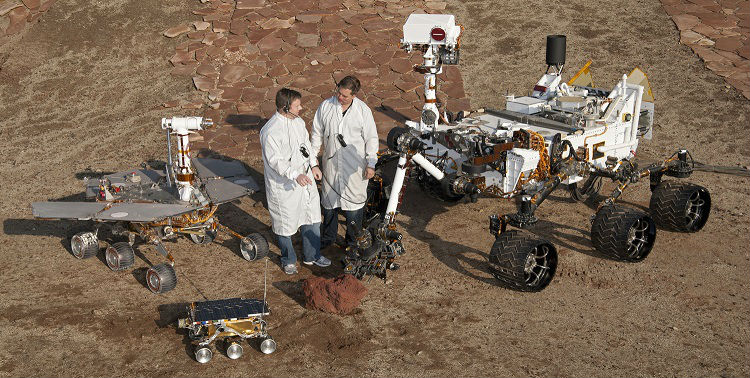 Sojourner (bottom left): 11.5 kilograms; Curiosity (right): 900 kilograms. Image: NASA.
Sojourner (bottom left): 11.5 kilograms; Curiosity (right): 900 kilograms. Image: NASA.
Remember: NASA is on a Journey to Mars. Everything the agency has been doing for the past half-decade has been specifically geared towards the goal of putting human bootprints on Mars about twenty years from now. But the agency is also grossly underfunded for this particularly journey, and just the act of constructing the basic hardware (the SLS rocket andOrion spacecraft) to enable human spaceflight beyond Earth orbit has been locking up a significant percentage of NASA's overall budget—money that could have been used to send more rovers to other destinations.
Unfortunately, the agency remains reluctant to send future landers anywhere other than into the Martian wilderness. With the mounting costs associated with the Journey to Mars, exploratory missions to other worlds—especially when they involve expensive and complicated landers/rovers—are being put on hold to ensure that NASA has enough resources to develop its future manned Mars missions.
A TALE OF TWO PLANETS AND TWO MOONS.
A glimpse at history reveals a multitude of ambitious missions to put robotic landers on other planets early in the space age. This effort was led by the USSR at the height of the space race, with NASA usually following along anywhere from a few months to a few years behind their Soviet counterparts.
In 1966, the Soviet-made Luna 9 made the first successful soft landing on the Moon, operating for about three days before running out of power. Then, in 1970, the Soviets made the first soft-landing on another planet with Venera 4, which touched down on the surface of Venus and transmitting data back to Earth for 23 minutes before losing contact. They made another epic first in 1971, landing the first robotic probe, Mars 3, on the surface of Mars—but this one only transmitted for 20 seconds before cutting out, and failed to return any legible images.
Following these early successes, the Soviet Space Program began falling behind in the realm of robotic probes and shifted its focus towards building space stations in Low-Earth Orbit (LEO). It wasn't until 2005 that NASA and the European Space Agency (ESA) set down a new robotic lander on a new world: their Huygens probe landed on Saturn's largest moon, Titan, and became the first spacecraft to land on an object in the Outer Solar System.
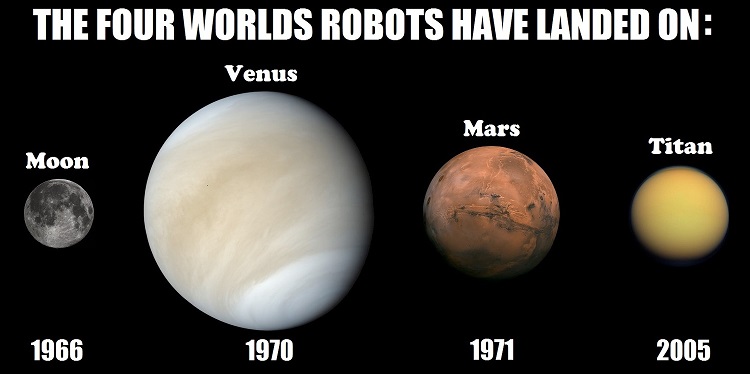 A portrait of all of the worlds we've landed robots on, sized to scale. Image: Dan Levesque.
A portrait of all of the worlds we've landed robots on, sized to scale. Image: Dan Levesque.
Portrait of all the worlds we've landed robots on, sized to scale. Image: Dan Levesque.
The Moon
Although the Soviet Space Program was successful early on in lunar exploration, NASA eventually outpaced the Soviets and landed a total of twelve astronauts on the Moon. As a way to compete against these six successful Apollo missions, the last of which landed in 1972, the Soviets sent two lunar rovers and three robotic sample-return missions that brought back a total of 300 grams of lunar dust (compared to Apollo's 380 kilograms of lunar dust and rocks).
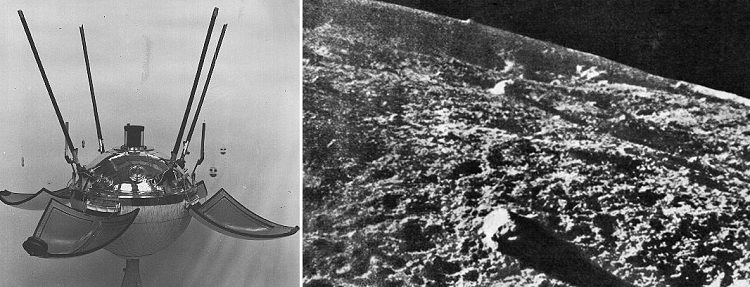 Luna 9 was the first object to successfully land on the Moon. Image: NASA.
Luna 9 was the first object to successfully land on the Moon. Image: NASA.
The last of these sample-return missions ended in 1976, with the Soviets (and their Russian successors) deciding to turn their attention towards developing a Mars sample-return mission (which hasn't gotten very far). After a 37-year hiatus on having robots sent to the lunar surface, China landed its own rover, Chang'e 3, on the Moon in 2013, becoming only the third country to successfully land a robotic vehicle on the Moon.
Lunar exploration is now going through a revival, with China, India, and Russia all planning on sending rovers to explore the lunar surface in the near future—though these rovers will likely be significantly less advanced than those being sent to Mars by NASA and ESA.
Venus
Following the early success of Venera 4, the Soviets continued operations on Venus up until 1985, landing a total of 10 robotic craft that operated for an average of about an hour. NASA only bothered landing one probe that operated for 67 minutes—the extreme heat and crushing atmospheric pressure of Venus aren't particularly friendly to electronics.
 The Soviet-made Venera 9 and Venera 10 sent back the first images of Venus' surface. Image: NASA.
The Soviet-made Venera 9 and Venera 10 sent back the first images of Venus' surface. Image: NASA.
Without a clear path to furthering ground-based exploration of this hellish planet, the surface of Venus hasn't been visited by a lander since 1985. The search for Venusian life never even started, and for whatever reason there's been very little interest in improving our understanding of the 2nd planet from the sun.
Mars
After an initial bout of competition, the story of Martian exploration took an unexpected turn—it's remained very one-sided ever since NASA landed its first robotic craft there in 1976. After the Soviets landed their 20-second Mars 3 in 1971, none of their follow-up Mars landers was successful, with a vast number of them failing to even achieve Mars orbit. In 2003, ESA landed their Beagle 2 on Mars, but its solar panels failed to deploy and it was never able to make contact with Earth. Other than that, the rest has been all NASA.
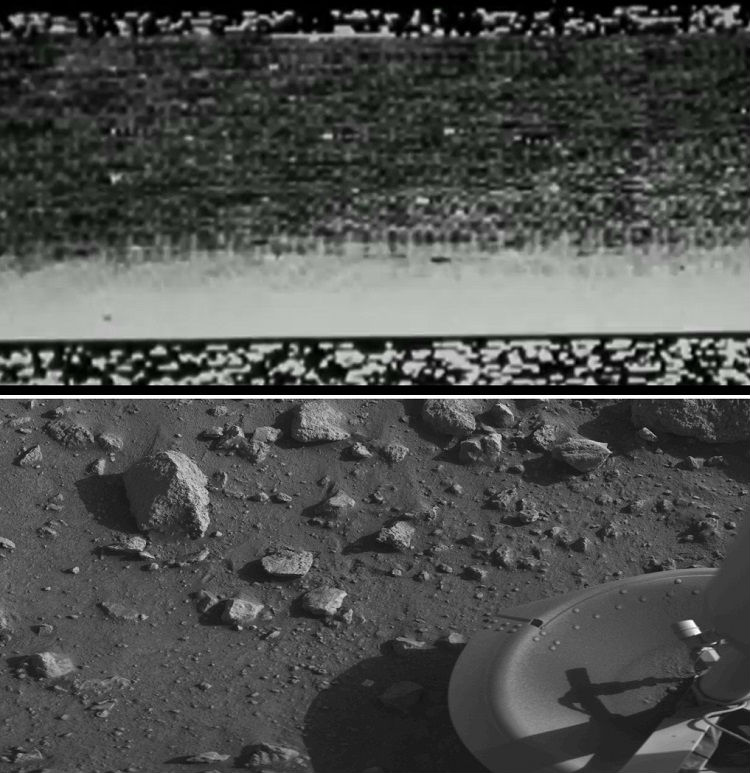 Top: The only image returned by the Soviet Mars 3 lander (1971). Bottom: The first 'real' image of Mars taken by Viking 1 (1976). Image: NASA.
Top: The only image returned by the Soviet Mars 3 lander (1971). Bottom: The first 'real' image of Mars taken by Viking 1 (1976). Image: NASA.
Since Viking 1 landed in 1976, NASA has put a total of seven successful (and successively more fruitful) landers on Martian soil (four of which have included rovers), losing only one in the process.
But ESA, partnered with Roscosmos (the Russian successor to the Soviet Space Program), is coming in hot with a new attempt at landing fresh wheels on Martian sand dunes. The ExoMars Trace-Gas Orbiter launched in March 2016 and included a test-lander that will attempt to land on the surface. If successful, the ESA's ExoMars Rover will launch in 2018 with a suite of instruments designed to find life on the red planet, if it exists.
And NASA has two additional surface missions slated to launch in 2018 and 2020. And to make things even more exciting, ESA, Roscosmos, and NASA have all expressed interest in designing a cooperative sample-return mission: a robot that could land on Mars, collect samples of Martian soil, and load them onto a small rocket (that either came with the lander or separately) that would then launch the samples back to Earth for analysis. If all goes well with this next round of Mars rovers, we could realistically see Martian sample-return take flight sometime in the mid- to late-2020's.
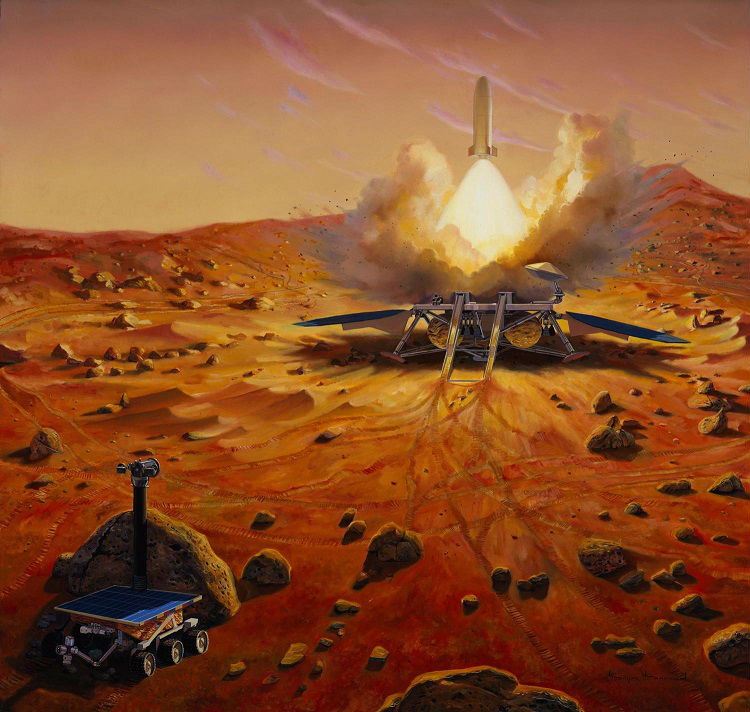 Artist's impression of what a sample return mission will look like. Note the little Sojourner-esque rover hiding behind a rock. Image: NASA/JPL.
Artist's impression of what a sample return mission will look like. Note the little Sojourner-esque rover hiding behind a rock. Image: NASA/JPL.
Titan
About 1.5 billion kilometers away from Earth (Mars sits at an average of 225 million kilometers) sits Saturn and its rings; within this system of rings is the second largest moon in the solar system, Titan. After Earth's moon, it's the only other moon in the Solar System that has had a spacecraft land on it.
As part of the joint NASA/ESA Cassini-Huygens mission, the Huygens probe detached from Cassini in late 2004 while in orbit around Saturn, and the lander successfully set down on Titan on January 14, 2005.
Huygens operated for 90 minutes on Titan, and the data returned from this mission is the best we have to date on this strange world and its lakes of liquid methane. With this thoroughly alien environment, there's definitely a chance that Titan could host some bizarre form of life that would be totally different from any life that we know of (and different from any life we may expect to find on Mars).
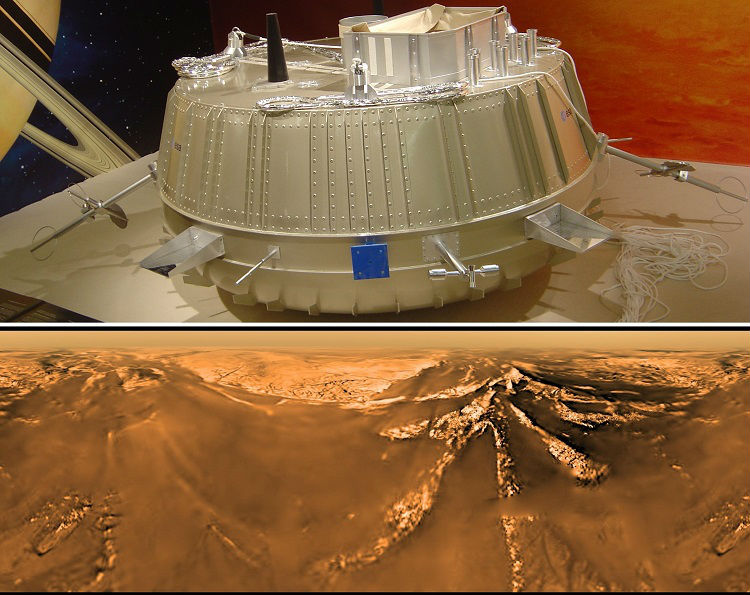 Top: Display model of the Huygens probe. Bottom: image taken by Huygens while descending to the surface of Titan (2005). Image: ESA/NASA/JPL/University of Arizona.
Top: Display model of the Huygens probe. Bottom: image taken by Huygens while descending to the surface of Titan (2005). Image: ESA/NASA/JPL/University of Arizona.
Ever since Huygens' historic mission to this outer world, there have been a huge range of proposals for follow-up missions. The simplest of these involves having a probe splash down in one of Titan's methane lakes, where it would float for 3-6 months gathering data and relaying it back to Earth.
But with its singular focus on Mars, NASA has remained reluctant to develop another lander destined for the outer solar system—but then along came politics.
THE MURKY WATERS OF BUREAUCRACY
Since NASA is officially on a Journey to Mars, most of their activities are geared towards Martian exploration and developing the technologies they need to eventually plant human bootprints in Martian soil. Even NASA administrator Charles Bolden, while speaking at a press conference after New Horizons' successful flyby of Pluto, related that "Today's mission was one more step on a Journey to Mars," which is slightly confusing given that Pluto is many billions of kilometers away from Mars—and in the opposite direction.
But there is a history here—and it's a jumbled mess:
Back in 2004, the impending retirement of NASA's Space Shuttle was about to leave the U.S. without a means of launching astronauts into space (this ended up happening in 2011, and NASA astronauts have had to hitch rides on Russian rockets ever since). President G. W. Bush was in office at the time, and he called for the development of the Space Launch System (SLS)—a new heavy-lift rocket of similar capacity to the Saturn V—and the Orion spacecraft, a vehicle that looks strikingly similar to the Apollo capsule of the 1960's.
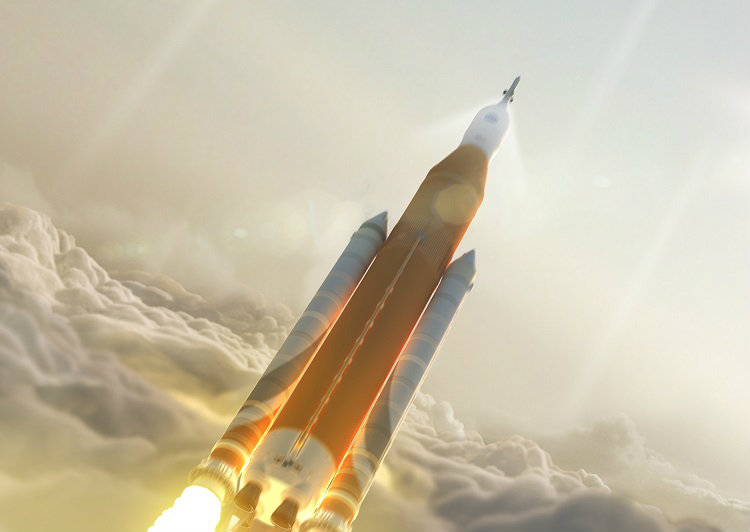 Artist's concept of what the SLS will look like when it finally launches. Image: NASA.
Artist's concept of what the SLS will look like when it finally launches. Image: NASA.
G. W. Bush's plan was for astronauts to return to the Moon no later than 2020 using the newly developed SLS and Orion, after which NASA would begin planning an expensive trip to Mars, possibly even launching from the Moon. Under this scenario, NASA would move away from LEO operations and begin using the lunar surface as a proving ground to develop the hardware and techniques needed to take astronauts to Mars and back, safely.
By 2009, development of the SLS and Orion package was running over-budget and behind schedule. This push to the Moon had resulted in multiple new lunar orbiters and a renewed interest in lunar science, but the agency still lacked a clear path and a good reason for going there in the first place. Then, the administration changed. Obama took office in 2009 and decapitated the Moon plan, stating "we've been there before," and planning to put theSLS/Orion on hold in favor of having NASA focus on developing new technologies before deciding on what hardware to build and for what purpose.
But Congress refused to allow the agency to scrap the SLS/Orion program, allegedly due to some aggressive lobbying by big aerospace contractors who are set to make a lot of money building many expensive SLS rockets over the coming decades. Whatever the cause, Congress wrote into law that NASA would use a designated percentage of its overall budget to complete the SLS/Orion program, regardless of whether or not it would be used to go to the Moon. Obama was forced to accept this deal, and decided that NASA's new task would be to put humans on the Mars sometime in the 2030's—a new use for the SLS. And thus began NASA's Journey to Mars.
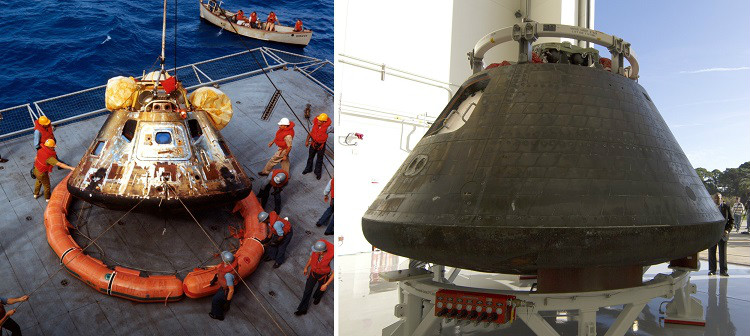 Strangely familiar: a comparison between Apollo (left, 1969) and Orion (right, 2015). Image: NASA/Cory Huston.
Strangely familiar: a comparison between Apollo (left, 1969) and Orion (right, 2015). Image: NASA/Cory Huston.
The shift to Mars brought with it a significantly greater technical challenge than the original plan to go to the Moon, but without any increase in funding that would actually make a manned mission to Mars feasible. An excellent article that goes into the gritty details about why NASA has essentially been strong-armed into going to Mars can be read HERE (via Ars Technica).
With the red planet now firmly set in their sights (by political maneuvering), NASA has been at work building two new Mars landers: InSight, a robot that will study the past and present geology of Mars more in-depth than ever before, is set to launch in 2018 (after a recent two-year delay). Following this, Mars 2020, a new rover with a similar design to that ofCuriosity but which will instead be specifically looking for past or present signs of life on Mars, is set to launch in 2020 (but has yet to experience any delays, which is unheard of, so we should expect a 2022 announcement).
Add ESA's 2018 Mars rover to this all-star lineup and it begins to look like the golden-era of Mars exploration, largely motivated by NASA's ongoing Journey to Mars.
But it's also easy to see why, despite some public outcry, NASA has been reluctant to begin development on either a) sending a follow-up lander to Titan, or b) sending a lander to one of the icy moons of Jupiter. Bogged down by the ongoing development of SLS/Orion and an ambitious timeline for a manned mission to Mars, the agency has been starved of both time and resources. And that's a classic recipe for further bureaucratic meddling.
For NASA's Fiscal Year 2016 budget, Congress awarded the agency an extra $700 million above what it had initially asked for, granting the agency a total of $19.3 billion for the year. The catch was that most of this extra money would be funneled towards ensuring that certain projects are completed in a timely manner: specifically SLS/Orion. Of what was leftover, $175 million was designated to developing a robotic lander to explore Jupiter's moon, Europa, which is known to contain a liquid water ocean trapped beneath a surface layer of ice.
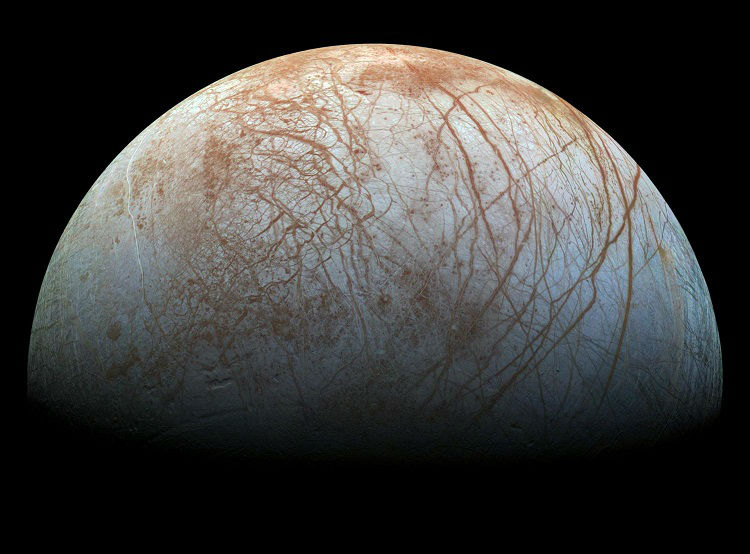 Europa, that icy moon of Jupiter. This should be the target of a new lander. Image: NASA/Jet Propulsion Lab-Caltech/SETI Institute.
Europa, that icy moon of Jupiter. This should be the target of a new lander. Image: NASA/Jet Propulsion Lab-Caltech/SETI Institute.
This is somewhat of a political trick by Congress. They've given NASA more money than they asked for, but sneakily appropriated most of those extra funds towards ensuring thatSLS/Orion makes its first flight sooner rather than later—which coincidentally benefits a few big aerospace contractors. The catch-22 is that NASA would be foolish to complain, having received more money than they asked for—just not in the programs that they would have liked. Thus, the agency is forced to remain (somewhat) quiet and continue doing what's been mandated by Congress—yet again.
AN AGENCY THAT HAS LOST ITS WAY
Charles Bolden, administrator of NASA, had this to say about Congress' 2016 budget allocations:
“My scientific community, the people who do mission planning, say we need to go and do a little research with the first mission to Europa to determine whether that’s a place we want to send a lander... That’s the point of our big disagreement with Congressman Culberson right now. He wants a multi-billion dollar Europa mission that has a lander on the first flight and everything. Our belief is that that is imprudent from a scientific perspective.”
Ever since SLS/Orion began development in 2004, NASA has been gradually losing control of its own space program. Having been forced to continue development on a rocket that is grossly over-budget and not even powerful enough to take humans to Mars (which it wasn't designed for in the first place), the political flip-flopping between the Moon and Mars has resulted in NASA having lost its way forward.
As Bolden sees it, designing a complicated Europa mission that includes a robotic lander just doesn't fit under the agency's Journey to Mars umbrella, which is behind schedule as-is (SLS needs to be upgraded to launch a manned mission all the way to Mars, Orion is too small to sustain a crew for a 6-month journey [not even including the trip home], and development hasn't begun on a Martian descent/ascent system).
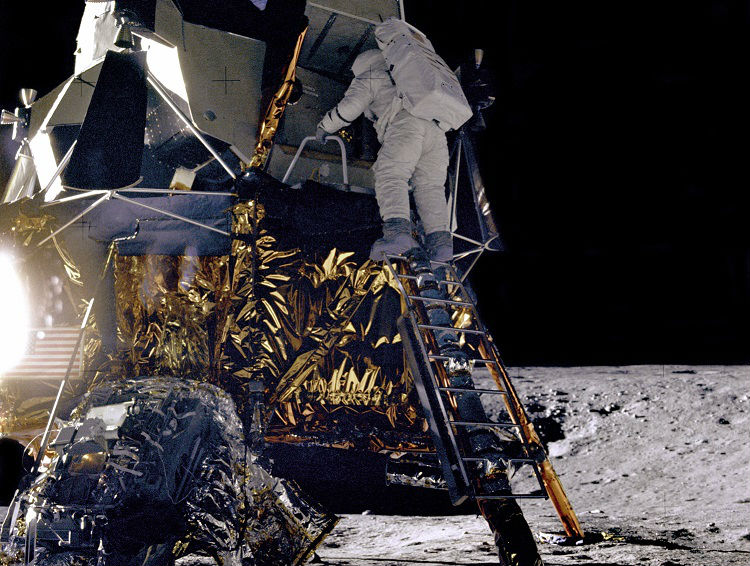 Better days: Astronaut Alan Bean climbs down from the Apollo 12 Lunar Module. Image: NASA.
Better days: Astronaut Alan Bean climbs down from the Apollo 12 Lunar Module. Image: NASA.
Historically, NASA received 4.5% of the United States' total federal budget while it was dedicated towards the singular goal of landing humans on the Moon in 1969. But today, NASA is expected to develop multiple complicated robotic probes while at the same time embarking on a manned Journey to Mars—which is a far more technically complicated task—while receiving less than 0.5% of total government spending here in 2016.
When it comes to political manipulation, NASA is being steered along like a puppet on strings. JFK was a puppet-master who really knew how to put that puppet to meaningful use, but the puppeteers of today are ever-changing. It's certain that we'll begin seeing proposals for a return to the Moon as SLS/Orion near completion—Mars is still a long way off, but the Moon is right next door (and NASA will have some of the hardware it needs to get there).
In the world of politics, one man's Moon is another man's Mars. It doesn't matter where you choose to go, as long as you need a couple of expensive, disposable, sub-contracted rockets to get you there.
Further reading: "4 Reasons Sending Humans to Mars Actually Makes Sense."

